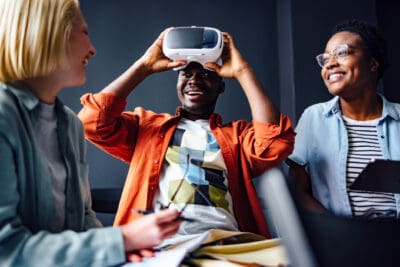Executive Summary
At Jobs for the Future (JFF), we’ve seen firsthand how technology enables economic advancement. We believe that extended reality (XR) and real-time 3D (RT3D) technology will play an essential role in helping learners and workers better prepare for quality jobs, driving the creation of more quality jobs, and enhancing the quality of existing jobs, all necessary components of reaching JFF’s North Star goal. However, two significant adoption challenges stand in the way of making this future a reality: equity, ensuring that all voices are represented in XR and RT3D products and are empowered to use them, and scale, the ability to implement this technology in every classroom or workplace. Both challenges must be addressed before the true impact of this technology in education, workforce development, and the workplace can be fulfilled.
To understand how XR and RT3D technologies are reshaping how we learn, work, and hold jobs, focusing on equity and scale, we asked four questions of the Metaverse for All Innovation Circle, a group of education and workforce development practitioners, entrepreneurs, XR, and RT3D thought leaders :
- How can we ensure that the skills required to design, build, deploy, and maintain XR and RT3D solutions and content are distributed equitably?
- How can we ensure that incorporating the lived experiences of people facing barriers to economic advancement is standard industry practice in the development and deployment of XR, RT3D, and related technologies?
- How can we empower organizations to adopt XR and RT3D solutions?
- How can we ensure XR and RT3D technologies enable worker and learner opportunities and don’t perpetuate existing inequality in our employment and education systems?
After diving into these questions with the Innovation Circle, we developed this impact agenda to outline three principles for how the XR and RT3D ecosystems can both slow down to prioritize equity and speed up to scale:
- Closing the gap between creators, consumers, and beneficiaries
- Achieving buy-in around a shared vision that aligns and motivates all stakeholders
- Creating incentives for success
Achieving both equity and scale requires an ecosystem-level approach, as individual companies face numerous trade-offs, such as cost and time to market. Below, we explore the three principles in our impact agenda and provide recommendations for building a truly equitable and scalable metaverse for all. Some recommendations are new, others adapt successful practices from different XR and RT3D industry sectors for education and workforce development, and some have already been well-tested.



